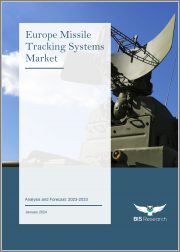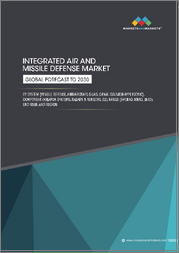
|
시장보고서
상품코드
1408029
유럽의 미사일 추적 시스템 시장 : 분석 및 예측(2023-2033년)Europe Missile Tracking Systems Market: Analysis and Forecast, 2023-2033 |
||||||
유럽의 미사일 추적 시스템 시장 규모는 2023년 213억 4,000만 달러에서 2033년 352억 6,000만 달러에 달할 것으로 예상되며, 예측 기간인 2023-2033년 CAGR은 5.15%에 달할 것으로 예상됩니다.
미사일 추적 시스템의 진화 여정은 현대 전쟁에서 정확성과 효율성의 필요성에 힘입어 기술 발전의 매혹적인 이야기로 펼쳐집니다. 제2차 세계대전에서 레이더 기술은 접근하는 적기를 탐지하고 추적하는 데 혁명적인 변화를 가져왔습니다. 과학자와 엔지니어들이 레이더가 비행기뿐만 아니라 미사일도 추적할 수 있다는 가능성을 인식하면서 초기 미사일 추적 시스템이 탄생했습니다. 그러나 이러한 초기 시스템은 오늘날의 정교한 기술에 비하면 초보적인 수준이었습니다. 냉전 기간 동안 미사일 추적 시스템은 크게 발전했습니다. 대륙간탄도미사일(ICBM), 아음속 미사일, 초음속 미사일, 그리고 최신 극초음속 미사일로 인한 위협에 대응하기 위해 더 강력하고 정확한 솔루션을 개발하려는 초강대국 간의 세계 경쟁이 원동력이 되었습니다. 이 시대에는 탄도미사일 조기경보시스템(BMEWS)과 소련판과 같은 첨단 미사일 추적 레이더 네트워크가 구축되어 엄청난 거리의 ICBM을 탐지하고 추적할 수 있게 되었습니다. 이후 위성 기반 시스템, GPS 센서, 적외선 센서가 통합되어 미사일 추적 능력이 더욱 강화되어 보다 정확한 미사일 탐지 및 요격이 가능해졌습니다.
| 주요 시장 통계 | |
|---|---|
| 예측 기간 | 2023-2033년 |
| 2023년 평가액 | 213억 4,000만 달러 |
| 2033년 예측 | 352억 6,000만 달러 |
| CAGR | 5.15% |
유럽의 미사일 추적 시스템 시장은 지정학적 긴장과 미사일 기술의 발전으로 인해 역동적인 변화를 겪고 있습니다. 지역 안보에 있어 견고한 미사일 추적 시스템이 매우 중요한 역할을 한다는 인식이 확산되면서 미사일을 정확하게 탐지, 추적, 요격할 수 있는 첨단 솔루션에 대한 수요가 증가하고 있습니다. 유럽 국가들은 미사일 방어 능력을 강화하기 위해 레이더 시스템, 적외선 센서, 위성 기반 추적 등 첨단 기술에 많은 투자를 하고 있습니다. 미사일 추적 시스템을 선택할 때 상호운용성, 확장성, 사이버 내성 등의 요소를 우선적으로 고려하는 것이 좋습니다. 새로운 미사일 위협을 효과적으로 방어하기 위해서는 유럽 국가와 업계 이해관계자들의 협력이 필수적입니다. 기술 발전과 규제 환경의 변화에 대한 정보를 지속적으로 파악하는 것은 유럽 미사일 추적 시스템 시장의 변화하는 상황을 헤쳐나가는 데 필수적입니다.
이 보고서는 유럽의 미사일 추적 시스템 시장에 대해 조사했으며, 시장 개요와 함께 용도별, 플랫폼별, 국가별 동향, 시장 진입 기업 개요 등을 제공합니다.
목차
주요 요약
조사 범위
제1장 시장
- 업계 전망
- 비지니스 역학
- 사업 전략
제2장 지역
- 미사일 추적 시스템 시장(지역별)
- 유럽
- 시장
- 응용
- 제품
- 유럽(국가별)
제3장 경쟁 벤치마킹과 기업 개요
- 시장 점유율 분석
- 기업 개요
- Thales
- Leonardo S.p.A.
- BAE Systems
- Weibel Scientific A/S
- ASELSAN A.S.
제4장 성장 기회와 제안
- 성장 기회
- 성장 기회 : 시스템 제조의 3D 프린팅 채용
- 성장 기회 : IoT 통합에 의한 미사일 추적 기능 강화
제5장 조사 방법
ksm 24.01.19“The Europe Missile Tracking Systems Market Market Expected to Reach $35.26 Billion by 2033.”
Introduction to Europe Missile Tracking Systems Market
The Europe missile tracking systems market is projected to reach $35.26 billion by 2033 from $21.34 billion in 2023, growing at a CAGR of 5.15% during the forecast period 2023-2033. The journey of missile tracking systems' evolution unfolds as a fascinating narrative of technological advancements, propelled by the imperative for precision and effectiveness in contemporary warfare. In World War II, radar technology brought about a revolutionary shift in detecting and tracking approaching enemy aircraft. As scientists and engineers recognized radar's potential for tracking not only airplanes but also missiles, it marked the inception of early missile tracking systems. However, these initial systems were rudimentary compared to today's sophisticated technology. Throughout the Cold War, there was a significant evolution in missile tracking systems, driven by the global competition between superpowers to develop more potent and accurate solutions in response to the escalating threat posed by intercontinental ballistic missiles (ICBMs), subsonic and supersonic missiles, and the latest entrant, hypersonic missiles. This era saw the establishment of advanced missile-tracking radar networks like the Ballistic Missile Early Warning System (BMEWS) and its Soviet counterpart, capable of detecting and tracking ICBMs across vast distances. Subsequent integration of satellite-based systems, GPS sensors, and infrared sensors further enhanced missile tracking capabilities, enabling more precise detection and interception of missiles.
| KEY MARKET STATISTICS | |
|---|---|
| Forecast Period | 2023 - 2033 |
| 2023 Evaluation | $21.34 Billion |
| 2033 Forecast | $35.26 Billion |
| CAGR | 5.15% |
Market Introduction
The European Missile Tracking Systems Market is experiencing a dynamic shift due to geopolitical tensions and ongoing advancements in missile technology. Recognizing the crucial role of robust missile tracking systems for regional security, there is an increased demand for advanced solutions capable of precisely detecting, tracking, and intercepting missiles. European nations are heavily investing in cutting-edge technologies such as radar systems, infrared sensors, and satellite-based tracking to enhance their missile defense capabilities. Prioritizing factors like interoperability, scalability, and cyber resilience is advised when selecting missile tracking systems. Collaborative efforts among European countries and industry stakeholders are crucial for an efficient defense against emerging missile threats. Staying informed about technological advancements and regulatory changes is essential for navigating the evolving landscape of the European Missile Tracking Systems Market.
Market Segmentation:
Segmentation 1: by Application
- Target Acquisition
- Air Defense
- Space Domain Awareness
- Early Warning Capabilities
Segmentation 2: by Platform
- Space-Based Missile Tracking Systems
- Ground-Based Missile Tracking Systems
- Naval-Based Missile Tracking Systems
- Airborne-Based Missile Tracking Systems
Segmentation 3: by Country
- U.K.
- Germany
- France
- Russia
- Rest-of-Europe
How can this report add value to an organization?
Product/Innovation Strategy: The product segment helps the reader understand the different types of products available for deployment and their potential in Europe region. Moreover, the study provides the reader with a detailed understanding of the missile tracking systems market by application on the basis of application (target acquisition, air defense, space domain awareness, and early warning capabilities) and product on the basis of platform (space-based missile defense systems, ground-based missile defense systems, naval-based missile defense systems, and airborne-based missile defense systems).
Growth/Marketing Strategy: The missile tracking systems market has seen major development by key players operating in the market, such as business expansion, partnership, collaboration, and joint venture. The favored strategy for the companies has been partnerships and contracts to strengthen their position in the missile tracking systems market.
Competitive Strategy: Key players in the missile tracking systems market analyzed and profiled in the study involve major missile tracking systems offering companies providing missile tracking systems for the purpose. Moreover, a detailed competitive benchmarking of the players operating in the missile tracking systems market has been done to help the reader understand how players stack against each other, presenting a clear market landscape. Additionally, comprehensive competitive strategies such as partnerships, agreements, and collaborations will aid the reader in understanding the untapped revenue pockets in the market.
Methodology: The research methodology design adopted for this specific study includes a mix of data collected from primary and secondary data sources. Both primary resources (key players, market leaders, and in-house experts) and secondary research (a host of paid and unpaid databases), along with analytical tools, are employed to build the predictive and forecast models.
Key Market Players and Competition Synopsis
The companies that are profiled have been selected based on thorough secondary research, which includes analyzing company coverage, product portfolio, market penetration, and insights gathered from primary experts.
Some prominent names established in this market are:
|
|
Table of Contents
Executive Summary
Scope of the Study
1. Market
- 1.1. Industry Outlook
- 1.1.1. Missile Tracking Systems Market: Overview
- 1.1.2. Evolving Missile Tracking Technologies in the Defense Industry
- 1.1.3. On-going and Upcoming Programs
- 1.1.3.1. Hypersonic and Ballistic Tracking Space Sensor (HBTSS)
- 1.1.3.2. Proliferated Warfighter Space Architecture (PWSA)
- 1.1.4. Future Technological Trends
- 1.1.4.1. Artificial Intelligence
- 1.1.4.2. Over-the-Horizon Radar
- 1.1.5. Comparative Analysis of Different Platforms
- 1.1.5.1. Ground-based Missile Tracking Systems
- 1.1.5.2. Naval-based Missile Tracking Systems
- 1.1.6. Value Chain Analysis
- 1.2. Business Dynamics
- 1.2.1. Business Drivers
- 1.2.1.1. Geopolitical Conflicts and Tensions
- 1.2.1.2. Emerging Hypersonic Armament Capabilities
- 1.2.1.3. Replacement of Legacy Systems
- 1.2.2. Business Challenges
- 1.2.2.1. Advancements in Stealth Technologies
- 1.2.2.2. Complex Sensor Integration
- 1.2.2.3. Efficient Data Transmission
- 1.2.3. Business Opportunities
- 1.2.3.1. AI and ML Integration
- 1.2.3.2. Directed Energy Weapons
- 1.2.1. Business Drivers
- 1.3. Business Strategies
- 1.3.1. Partnerships, Collaborations, Agreements, and Contracts
- 1.3.2. Market Developments
2. Region
- 2.1. Missile Tracking Systems Market (by Region)
- 2.2. Europe
- 2.2.1. Market
- 2.2.1.1. Key Manufacturers in Europe
- 2.2.1.2. Business Drivers
- 2.2.1.3. Business Challenges
- 2.2.2. Application
- 2.2.2.1. Europe Missile Tracking Systems Market (by Application)
- 2.2.3. Product
- 2.2.3.1. Europe Missile Tracking Systems Market (by Platform)
- 2.2.4. Europe (by Country)
- 2.2.4.1. U.K.
- 2.2.4.1.1. Market
- 2.2.4.1.1.1. Key Manufacturers in the U.K.
- 2.2.4.1.2. Application
- 2.2.4.1.2.1. U.K. Missile Tracking Systems Market (by Application)
- 2.2.4.1.3. Product
- 2.2.4.1.3.1. U.K. Missile Tracking Systems Market (by Platform)
- 2.2.4.1.1. Market
- 2.2.4.2. France
- 2.2.4.2.1. Market
- 2.2.4.2.1.1. Key Manufacturers in France
- 2.2.4.2.2. Application
- 2.2.4.2.2.1. France Missile Tracking Systems Market (by Application)
- 2.2.4.2.3. Product
- 2.2.4.2.3.1. France Missile Tracking Systems Market (by Platform)
- 2.2.4.2.1. Market
- 2.2.4.3. Germany
- 2.2.4.3.1. Market
- 2.2.4.3.1.1. Key Manufacturers in Germany
- 2.2.4.3.2. Application
- 2.2.4.3.2.1. Germany Missile Tracking Systems Market (by Application)
- 2.2.4.3.3. Product
- 2.2.4.3.3.1. Germany Missile Tracking Systems Market (by Platform)
- 2.2.4.3.1. Market
- 2.2.4.4. Russia
- 2.2.4.4.1. Market
- 2.2.4.4.1.1. Key Manufacturers in Russia
- 2.2.4.4.2. Application
- 2.2.4.4.2.1. Russia Missile Tracking Systems Market (by Application)
- 2.2.4.4.3. Product
- 2.2.4.4.3.1. Russia Missile Tracking Systems Market (by Platform)
- 2.2.4.4.1. Market
- 2.2.4.5. Rest-of-Europe
- 2.2.4.5.1. Application
- 2.2.4.5.1.1. Rest-of-Europe Missile Tracking Systems Market (by Application)
- 2.2.4.5.2. Product
- 2.2.4.5.2.1. Rest-of-Europe Missile Tracking Systems Market (by Platform)
- 2.2.4.5.1. Application
- 2.2.4.1. U.K.
- 2.2.1. Market
3. Competitive Benchmarking and Company Profiles
- 3.1. Market Share Analysis
- 3.2. Company Profiles
- 3.2.1. Thales
- 3.2.1.1. Company Overview
- 3.2.1.1.1. Role of Thales in the Missile Tracking Systems Market
- 3.2.1.1.2. Product Portfolio
- 3.2.1.2. Corporate Strategies
- 3.2.1.2.1. Partnerships, Collaborations, Agreements, and Contracts
- 3.2.1.3. Analyst View
- 3.2.1.1. Company Overview
- 3.2.2. Leonardo S.p.A.
- 3.2.2.1. Company Overview
- 3.2.2.1.1. Role of Leonardo S.p.A. in the Missile Tracking Systems Market
- 3.2.2.1.2. Product Portfolio
- 3.2.2.2. Business Strategies
- 3.2.2.2.1. Market Developments
- 3.2.2.3. Analyst View
- 3.2.2.1. Company Overview
- 3.2.3. BAE Systems
- 3.2.3.1. Company Overview
- 3.2.3.1.1. Role of BAE Systems in the Missile Tracking Systems Market
- 3.2.3.1.2. Product Portfolio
- 3.2.3.2. Corporate Strategies
- 3.2.3.2.1. Partnerships, Collaborations, Agreements, and Contracts
- 3.2.3.3. Analyst View
- 3.2.3.1. Company Overview
- 3.2.4. Weibel Scientific A/S
- 3.2.4.1. Company Overview
- 3.2.4.1.1. Role of Weibel Scientific A/S in the Missile Tracking Systems Market
- 3.2.4.1.2. Product Portfolio
- 3.2.4.2. Analyst View
- 3.2.4.1. Company Overview
- 3.2.5. ASELSAN A.S.
- 3.2.5.1. Company Overview
- 3.2.5.1.1. Role of ASELSAN A.S. in the Missile Tracking Systems Market
- 3.2.5.1.2. Product Portfolio
- 3.2.5.2. Analyst View
- 3.2.5.1. Company Overview
- 3.2.1. Thales
4. Growth Opportunities and Recommendations
- 4.1. Growth Opportunities
- 4.1.1. Growth Opportunity: Adoption of 3D Printing in Systems Manufacturing
- 4.1.1.1. Recommendations
- 4.1.2. Growth Opportunity: Enhanced Missile Tracking Capabilities with IoT Integration
- 4.1.2.1. Recommendations
- 4.1.1. Growth Opportunity: Adoption of 3D Printing in Systems Manufacturing
5. Research Methodology
- 5.1. Factors for Data Prediction and Modeling



















